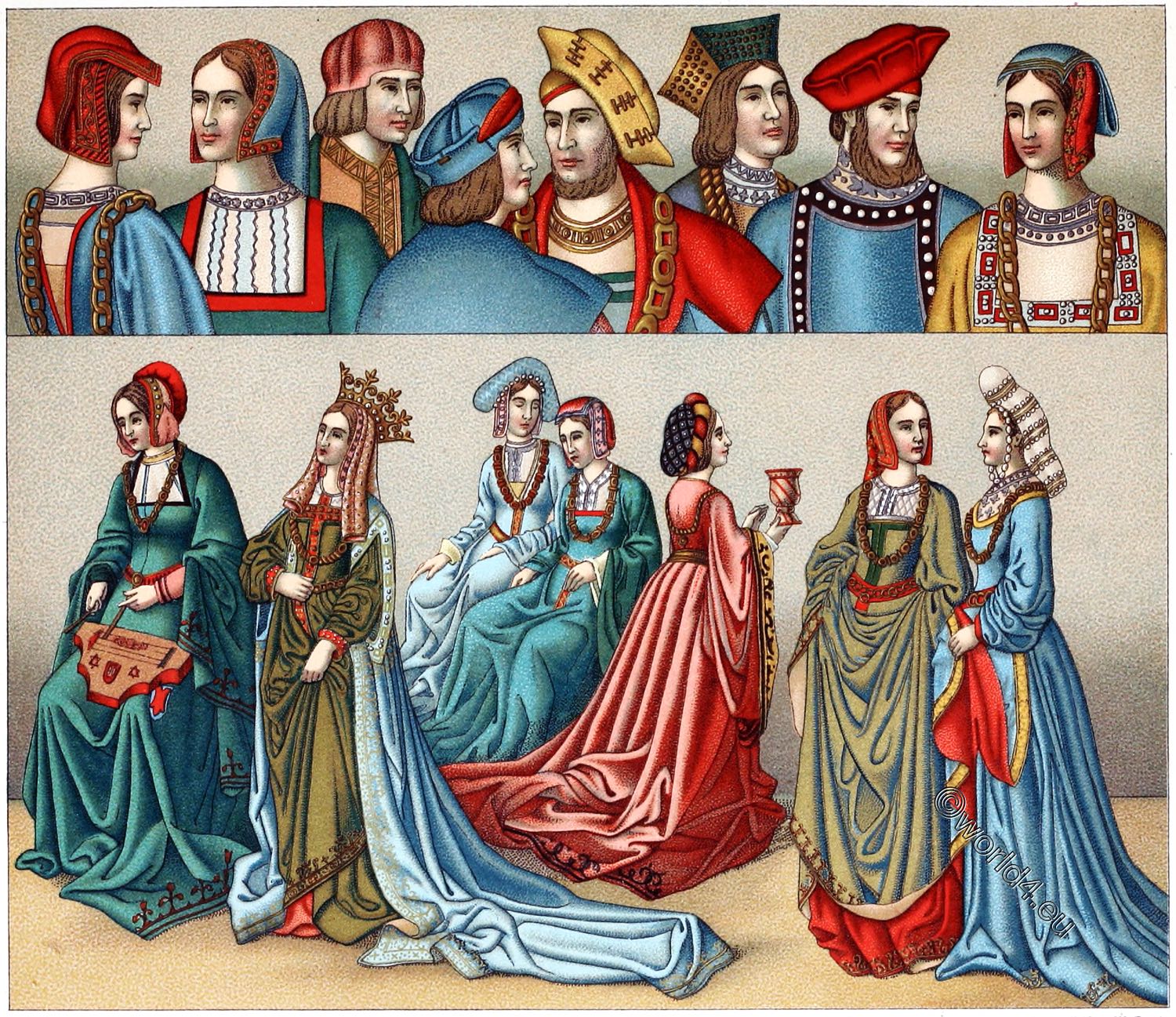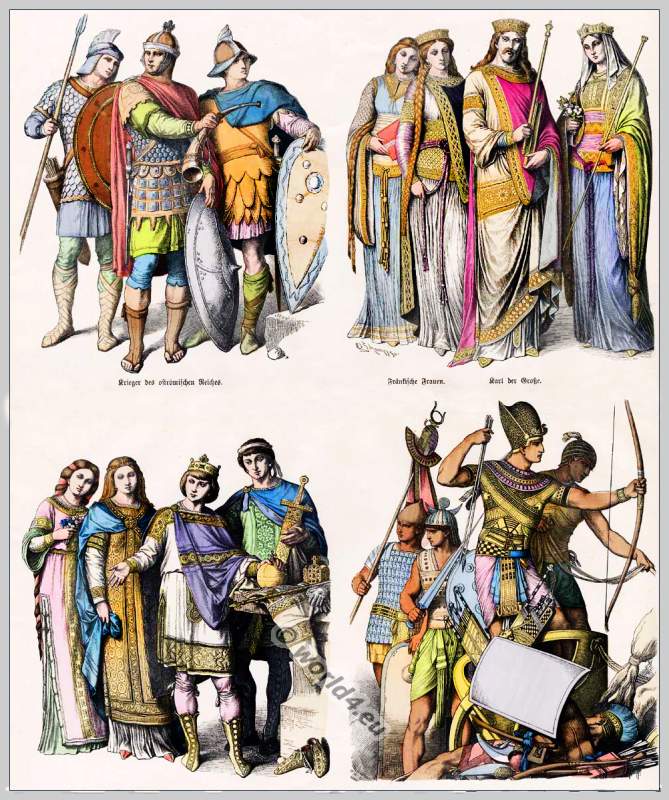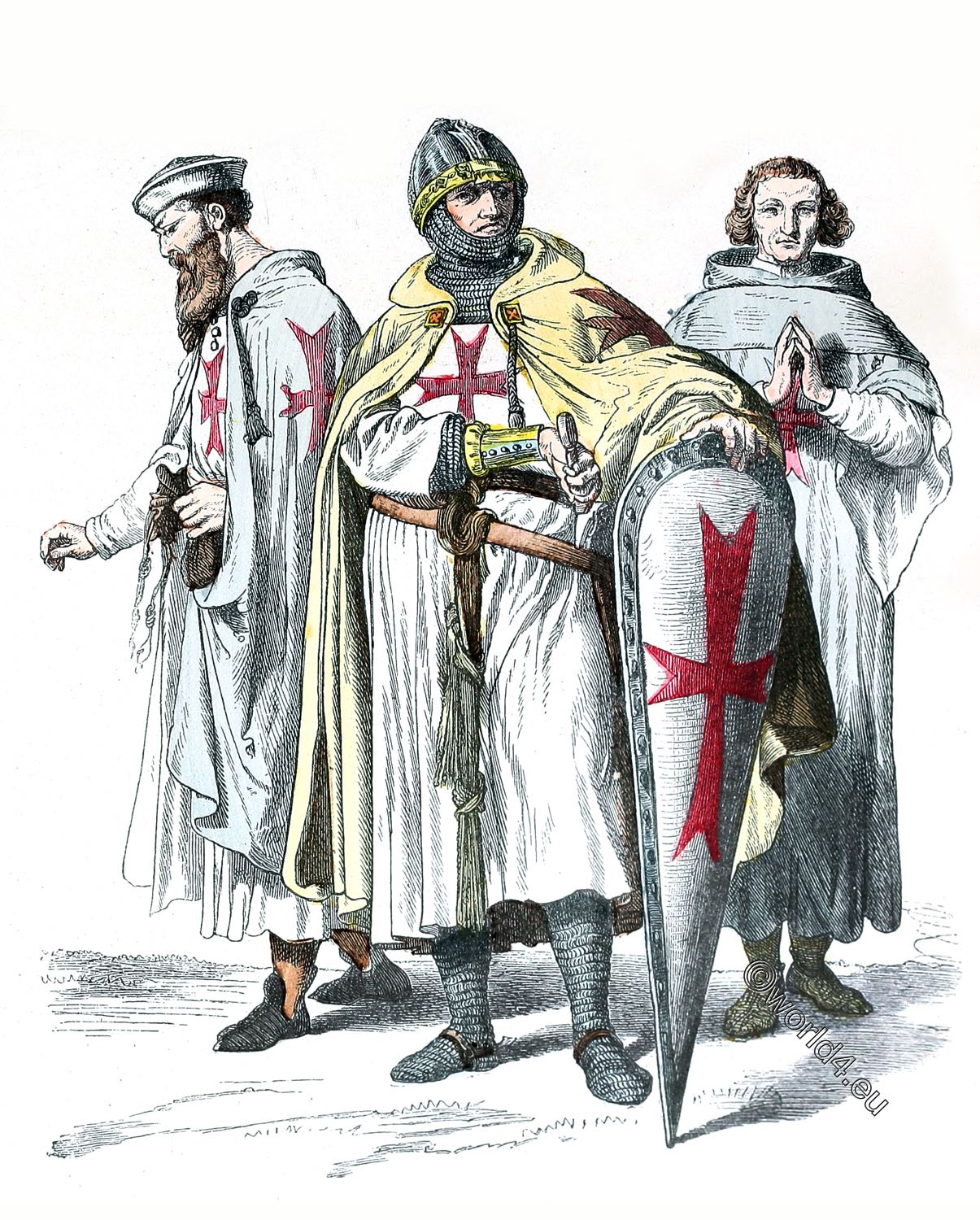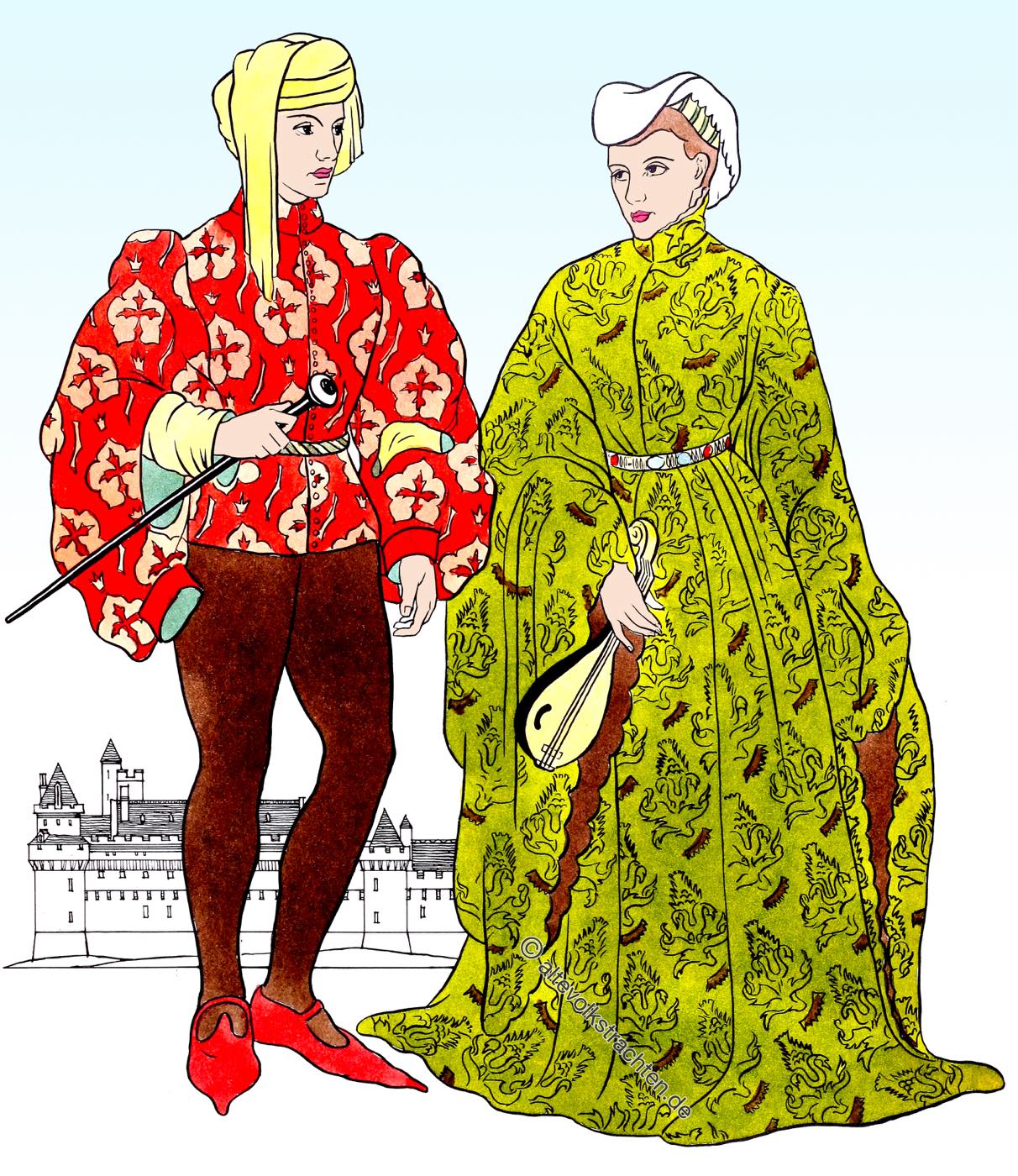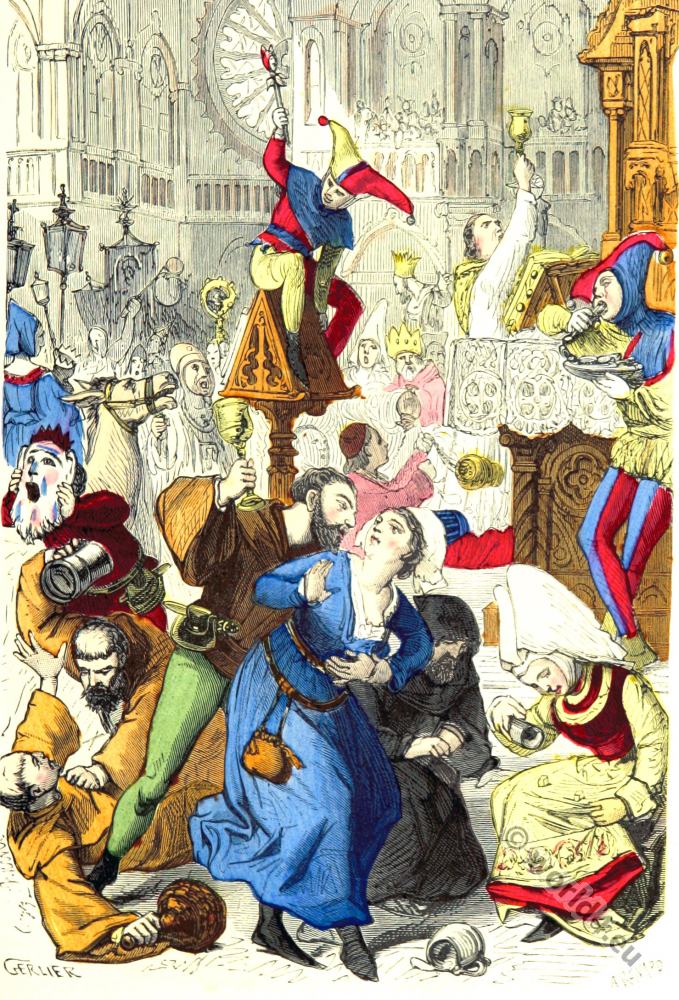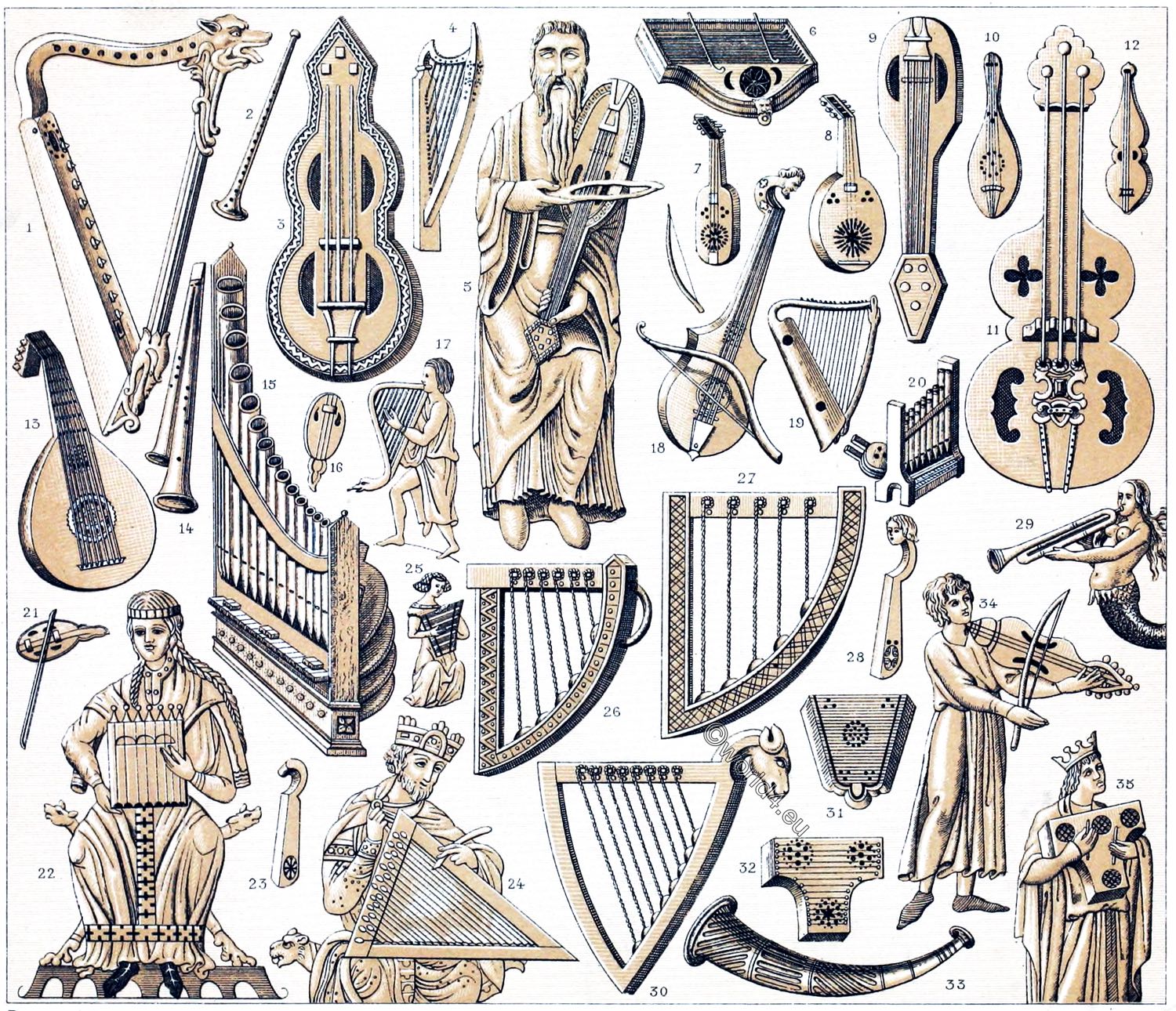
EUROPA. MIDDLE AGES. MUSICAL INSTRUMENTS FROM 12TH TO THE BEGINNING OF THE 16TH CENTURY.
Stringed instruments.
The harp, the psaltery, the rota, the lute, the mandora or gallichon, the guitar, the cittern or cithren and the citole.
The harp, known since the 9th century under the name cithara anglica, was used to accompany the singing. At the beginning it had 12 strings, in the 14th century 25. It was held on the knees when sitting, and on a band around the neck when standing. No. 24, belonging to the 10th or 9th century, is struck with the plectrum. No. 1, 19, 26, 27 and 30 are from the 12th century, No. 17 also from the 12th century, No. 4 from the 14th century.
The Psalterion is the santir or pi-santir of the Arabs and was brought to Europe by the crusaders. The soundboard of the psalterion is pierced by 1-4 sound holes; the strings are made of silver or a mixture of silver and gold; eagle feathers serve as percussion instruments.
The number of strings varies from 6 to 15; in the 14th century there were 32, in the 16th century 38. In the Middle Ages the psalterion was leaned against the chest (cf. nos. 22, 25, 35); in the 16th century it was placed on the knees or on a table.
No. 22 belongs to the 9th or 10th century, no. 31 to the 12th century, no. 25 to the 13th century, no. 32 and 35 to the 16th century, no. 6 to the beginning of the 16th century.
The Rota is a psalterion of rounded shape. From the fact that it had 7 strings in the 11th century and 17 in the 12th century, it follows that it was not played with a bow but with the hand.
The lute of the Middle Ages is the Arabic eud (oud), as it was imported to Spain in the 8th century and spread throughout Europe in the 12th century. The body of the lute was bulbous with elongated sides, gradually narrowing towards the neck, on which there was a fingerboard. The oval soundboard had a rosette-shaped opening in the middle. The pegs were located on either side of the head. The number of strings increased from four in the 16th century to 6, in the 17th century to 10.
The Mandora of the 12th century is a diminished lute. The only difference is that the head of the instrument is curved forward. It usually had 4, never more than 6 strings.
The guitar was known in France in the 14th century as guitare moresque. (The Guitare moresque was mentioned in 1349 in the hands of the ducal Norman Ménestrels.). The body of the instrument is bulbous, round or elongated, with a straight neck and more or less bent back head. In the Middle Ages it had 4, at the end of the 15th century 5 double and a single string, the chanterelle.
The cither is also a variant of this family; its neck is curved forward in a volute shape. The end of the strings is attached by an eyelet to pins which are turned by a key. One finds 16th century cithers with four double strings, which are tensioned by 8 swivels on either side of the head. In the 18th century the number of strings increases to eleven, five double and one single.
The citole of the French poets of the Middle Ages is a reduction of the cither.
The lutes, mandores, guitars and cithers of our Citole belong to the 12th century, No. 10 and 12 to the 4th century. No. 23 and 28 are citoles without strings; no. 13 is from the beginning of the 16th century.
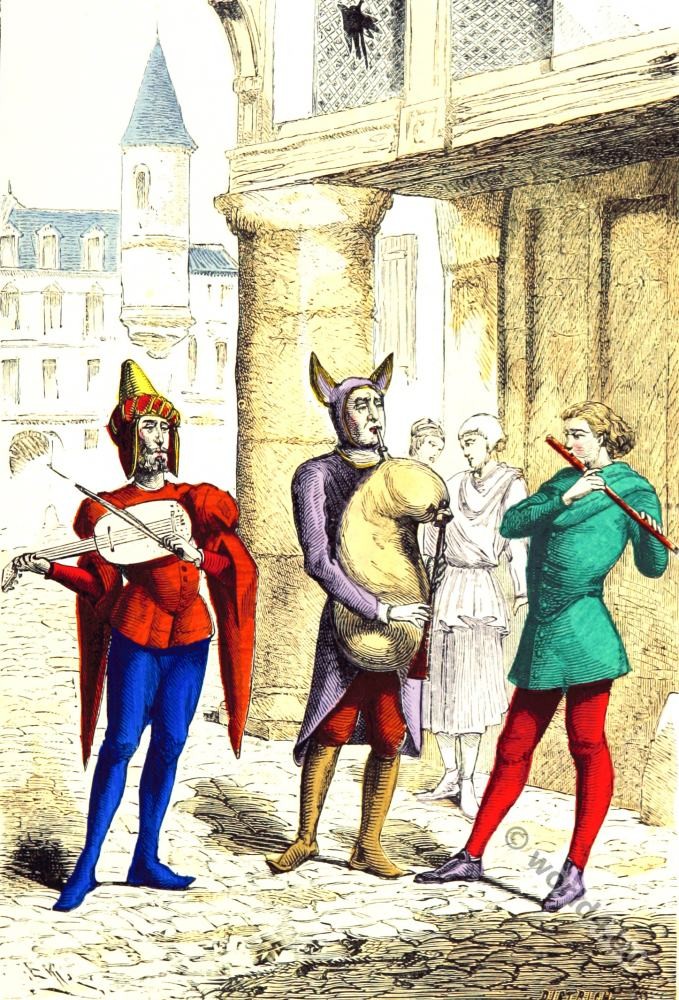
The rubebe, the violin, the rebec, the viola.
The rubebe had two strings; when playing it, one grasped it by the neck near the fingerboard and supported it on the knee. In addition to the older French form of the name rebebe, from the 13th to the 16th century the bowed lute was called rubeba (rubebe), Italian ribebe and English rebeck, among others.
The Rebec (sometimes rebecha, rebeckha) had a smaller soundboard and three strings and was not an instrument of courtly musicians; minstrels used it to play for the people to dance on. When playing it was leaned against the shoulder or chest or placed in the crook of the arm. The bundleless stringed instrument, derived from the North West African-Moorish rabab, came to us via Spain in the 10th/11th century.
The violin seems to have been originally made from a single piece of wood. It had three strings. They were made for playing together in different sizes.
The viola of the Middle Ages had a fingerboard marked by protruding cross bands. It was strung with 8, 4 or 5 strings. The oval body of the instrument showed no cut-out for the bow. In the 15th and 16th centuries, 4 violas of different sizes, with 3, 4, 5 and 6 strings, formed a musical ensemble.
No. 3, 5, 9 and 12 are from the 12th, 16 and 21 from the 13th, 7 and 35 from the 14th, 18 from the beginning of the 16th century.
Wind instruments.
Flute, hoboe, shawm, bagpipe, bombard, crumhorn, trumpet, trombone, horn.
No. 2 belongs to the genre of shawms, which goes back to Greek and Roman patterns. It is made of tube or metal, 14th century.
No. 14 is a double flute with a common mouthpiece. It belongs to the 16th century, as does horn no. 33, the latter being the Oliphant, the hunting and slaughter horn of the Middle Ages, which remained in use until the end of the 16th century. It is a simple mouthpiece made of ivory, from which material it got its name.
The best horns were made in the 15th century from rowan – or pear wood. They had 3, 6 and 8 holes, some with keys.
No. 29 is a Trombone from the 16th century.
Instruments with keyboards.
The clavicord, the portable organs, etc. all date back to the Arabic pisantir and qânon, to which a mechanical device for striking the strings was added. They did not develop until the 15th century, as they are not yet mentioned by the writers of the 13th and 14th centuries.
The name organ was used to describe a whole range of instruments, from the one attached to a band around the neck to the large church organ. The keyboard of the portable organ was played with one hand while the other moved the bellows.
No. 20 is a portable organ of the 14th century. No. 15 is larger and more complicated and belongs to the 16th century.
Nos. 1, 5, 11, 19, 26, 27 and 30 from the abbey of Saint-Denis; nos. 3, 9, 10, 12 and 31 from the portal of Chartres; nos. 16, 17 and 21 from a 13th century enamelled bowl.
No. 25 from a manuscript of the same period. Nos. 2, 4, 7, 8, 20, 23, 28, 32, 34 and 35 from manuscripts of the 14th century. Nos. 22 and 24 are communicated by Willemin, from whom all the illustrations are taken, without any indication of their origin.
Compare F. J. Fétis, Histoire générale de la musique depuis les temps les plus anciens jusqu’à nos jours, Paris.
Related
Discover more from World4 Costume Culture History
Subscribe to get the latest posts sent to your email.

